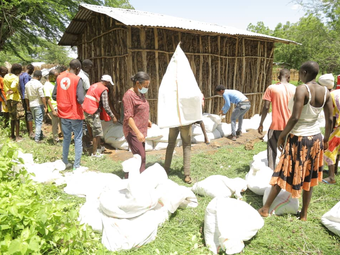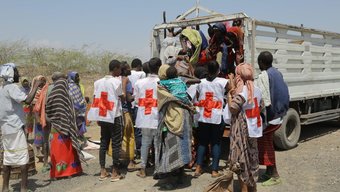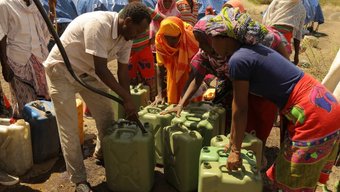Categories
Ethiopia
Key facts
Hazards covered by anticipation
Drought| Riverine floods
People reached by anticipation
Start Network, 2015: 104,732
Anticipation partners in country
FAO | WFP | Start Network: GOAL, Plan UK, Save the Children, Tearfund and World Vision | Ethiopia Red Cross Society | Netherlands Red Cross | National Disaster Risk Management Commission | National Meteorological Authority | Basin Development Authority | Ministry of Agriculture | Ministry of Health | Ethiopian Space Science Authority | Central Statistical Authority | FEWSNET
Inform Risk Index (2022)
Hazard and exposure: 7.3
Vulnerability: 6.4
Lack of coping capacity: 6.8
Total: 6.8 (very high)
Rank: 12
Photo (c) Caroline Hurford / IFRC
Country profile
Ethiopia is one of the least developed countries in the world, according to the Human Development Index. The country’s economy and people’s livelihoods are closely linked to the agricultural sector, which accounts for 85 per cent of total employment and 41 per cent of the country’s gross domestic product.
Ethiopia experienes a wide range of hazards associated with the country’s diverse geoclimatic conditions. these include floods, drought, heat waves, frost and hail, crop pests, disease, landslides, earthquakes and wildfires, as well as conflict. Of these, drought and floods are the most common and cause the highest impacts. Combined, they are estimated to put 7 million people at risk of food insecurity. Climate change is expected to further increase Ethiopia's exposure to climate-related and hydrological hazards, adding to the pressure on livelihoods and the country’s agriculture-dependent economy.
Drought, and a lack of or erratic rainfall, affect most of central and eastern Ethiopia. Lowland regions are particularly affected. On average, around 1.5 million people are affected by drought and water scarcity each year. Because most cereal crops are rainfed in Ethiopia, the agricultural sector is highly vulnerable to rainfall variability. Therefore, droughts often result in the loss of livestock and agricultural income, which in turn lead to food insecurity and severe food crises.
Large-scale riverine flooding occurs in lowland areas. In combination with highland flash floods, flood events cause the highest economic damage in Ethiopia. The impacts are mostly associated with damage to housing and infrastructure, the displacement of people, and the loss of crops and livestock. Both types of flood are becoming increasingly common in Ethiopia, exacerbated by deforestation, land degradation, increasing climate variability and shifting settlement patterns.
Projects
The Innovative Approaches to Response Preparedness (IARP) project in Ethiopia, Kenya and Uganda is implemented by the National Red Cross Societies of the three countries and supported by the Netherlands Red Cross, the British Red Cross, the 510.global data team and the Red Cross Red Crescent Climate Centre. The project aims to develop anticipatory actions and institutionalized early action protocols (EAPs) for flood and drought hazards in vulnerable areas in Ethiopia, Kenya and Uganda. This is supported by capacity development in areas of data preparedness and cash and voucher assistance. The development of the EAPs is done in close collaboration with national government agencies and UN agencies to ensure the harmonization of triggers (alert thresholds), early warning messages and anticipatory actions.
In 2015, the Start Network allocated £500,000 to GOAL, Plan UK, Save the Children, Tearfund and World Vision to help farmers secure seeds in anticipation of the rainy season, after a series of failed rains (Alert 65).
Since 2019, WFP has been working with government agencies and other partners to strengthen national capacities and systems for climate risk management, through the use and development of tailored climate forecasts and triggers for early action against agricultural drought.
FAO is working to support early action for drought in Ethiopia.
In 2020, the Ethiopia Red Cross Society began working closely with the National Disaster Risk Management Commission, the National Meteorological Agency, the Basin Development Authority, the Ministry of Agriculture, the Ethiopian Space Science Society, WFP and FAO to develop forecast-based financing for riverine floods. The Ethiopia Red Cross Society will submit their early action protocol to the FbA by the DREF financing mechanism.




